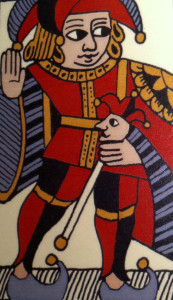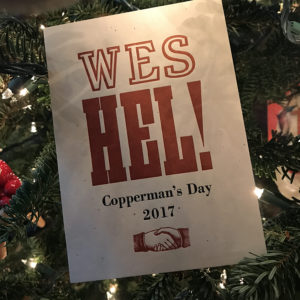
Here are thoughts gathered for the next few of these Twelve Days of Christmas. And with this chapter, I shall bid you peace, and then I shall be gone until the new year is a full day old. ‘Til then, Wassail!
FOURTH DAY of CHRISTMAS
December 29: The Feast of Fools
Six days in the old year, six days in the new: these are the Twelve Days of Christmas in the counting version we use here. And at this point, chaos begins to ensue. The old year is dying, unraveling before our eyes, disintegrating into chaos and entropy, like a spent star, collapsing in on itself before exploding into a supernova. And just as the matter that shoots violently into space from that supernova eventually comes together to form new stars and planets, so out of the chaos of the dying year a new year will be born. It happens each and every year. Another of those old, old stories on the wheel.
We are not fond of chaos, and yet here we are, just a few days before the new year, and the central theme of this Fourth Day of Christmas is one that in its early history covered the full Twelve Days. It is the Feast of Fools, where the normal order of things is ceremoniously reversed. The joker and the jester are in charge; the king and queen serve them. The practice was most prevalent in medieval Europe, and is a direct descendant of the Roman midwinter feast of Saturnalia, which is the source of so many of our Christmas traditions today.
And lest you think the misrule was just the stuff of homes and taverns, you may be surprised to learn that it even infiltrated places of worship. The Feast of Fools is known in Latin as Asinaria Festa, Feast of the Ass. It was a lowly ass upon which Mary rode into Bethlehem, and an ox and an ass, according to another lovely old carol, were there when the child was born in a stable that first Christmas night… and it was an ass that took top billing at some church services during the Twelve Days of Christmas in medieval times. The rules were bent even here, and during these Twelve Days of Christmas, donkeys and other animals were sometimes allowed in churches. There are even records of masses said during this time in which the normal response of “amen” was replaced with the entire congregation braying in unison.
So. Practical ways to incorporate the Feast of Fools today? If you have kids, how about putting them in charge of the day? Let them decide what’s for supper, and when it’s time to go to bed. Work? Why bother? Chaos is everywhere now; there’s no point in working. Maybe you should read (or watch) Alice in Wonderland instead––Lewis Carroll would have loved a day like this. The Lord of Misrule is in charge of the day. Just go with it. There are 364 normal days ahead.
There are no particular traditions associated with the Fifth Day of Christmas on December 30, but we have long reserved it as one for honoring the old “Boar’s Head Carol“ and for feasting (feasting being a common theme for all the Twelve Days)… and whatever we serve this night, whether it be something elaborate or something simple, we tend do it here with great fanfare. It’s a special night here at Convivio Bookworks if only because it was the Boar’s Head Carol that bestowed upon us our convivial name. This carol dates back to the 15th century. It’s a macaronic carol, meaning it combines common English with haughtier Latin, and the earliest known printing of the Boar’s Head Carol happens to be from a book published by the British printer Wynkyn de Worde in 1521. The book is called Christmasse Carolles. I happened to choose Wynkyn de Worde as the subject for my research in a History of the Book class I took as part of my book arts training at the University of Alabama… long before the idea of calling our press Convivio Bookworks took hold. For all these reasons, the Boar’s Head Carol is important to us here and this is the day we choose to honor it.
December 31 is, of course, New Year’s Eve and this is the focus for the Sixth Day of Christmas, as we say farewell to the old year and usher in the new.
SIXTH DAY of CHRISTMAS
December 31: New Year’s Eve, Hogmanay, First Footing
It’s the close of the old year, the welcoming of the new. New Year’s Eve, which comes tonight, is perhaps the most common night of the year for symbolic foods and rituals. Visit the grocery stores here in Lake Worth and the first thing you’ll see upon entering are black eyed peas and fresh collard greens, and not too far from them, champagne and grapes. Champagne at midnight on New Year’s Eve has become rather universal. The peas and greens are traditional New Year foods here in the South. As for the grapes, well, one old Italian tradition in my family is to eat twelve grapes at midnight for twelve months of luck; we used to do this, but I don’t push it anymore. On my dad’s side, Grandma Cutrone used to make sure everyone had a spoonful of lentils at the stroke of midnight. In fact, the humble earthy lentil, cooked in various savory dishes, is very big throughout Italy for Capo d’Anno, the New Year. Lentils symbolize riches (think of each lentil as a coin, and you’d have quite a stash in each bowl). “Out with the old” is also very big in Italy for New Year’s Eve, and Italians traditionally make a clean sweep of things at midnight, opening the windows and tossing old useless possessions out onto the streets, no matter from what height (and with great gusto, no less). It can be a dangerous night for a walk about! The act is rich in symbolism, though: this is a night to shed what is unwanted, to dispel bad energy, to clear the way for good things to come.
The only New Year’s Eve tradition that seems to be a requirement for my family is the zeppole. These are different from the zeppole we buy for St. Joseph’s Day in March; New Year’s Eve zeppole are a sort of fried doughnut––a yeast dough, much like pizza dough, but enriched with eggs. Mom will make the dough and let it raise and sometimes it will bubble up over the sides of the bowl it’s proofing in and then she’ll spoon the dough into hot oil, stretching the dough as it slides into the fat. The result is a light, fried treat that comes in all sorts of shapes that remind you of all sorts of things as you eat them, whether they be drizzled in honey or dusted in powdered sugar or cinnamon sugar. They are so delicious. My dad loved them much more than he liked lentils.
In Scotland, the new year celebration is the biggest part of the Yuletide season. The celebration there is known as Hogmanay, which is believed to to be derived from the French au gui menez, “lead to the mistletoe,” and this suggests a very ancient and pre-Christian derivation of most Hogmanay traditions, for it leads directly back to the Celtic druids and the mistletoe that was sacred to their ceremonies. “First Footing” is an aspect of Hogmanay that feels particularly like a magic spell: The first person to step across the threshold of the front doorway after midnight is the First Footer, and it is hoped that this person would be a red- or dark-haired man carrying whisky or mistletoe or, in some cases, bread, salt and coal. In this case he would kiss all the women and shake the hands of all the men before placing the coal on the fire and the bread and salt on the table and then he’d kiss all the women and shake hands with all the men once more on his way out.
SEVENTH DAY OF CHRISTMAS
January 1: New Year’s Day
For today, the First Day of the New Year, it is customary to brew a special hot Christmas punch and with it, toast the apple trees in the orchard. The act is called wassailing and the drink is wassail, too, and so is the toast: “Wassail!”… from the old English Wes Hel, “be of good health.” The response to the toast? “Drink hel!” Be well, drink well. So, get outside, honor your favorite tree, apple or not, give it a toast. Here is our Wassail recipe:
C O N V I V I O W A S S A I L
Pour the contents of two large bottles of beer or ale (about 4 pints) into a pot and place it on the stove to heat slowly. Add about a half cup sugar and a healthy dose of mulling spices. (If you don’t have mulling spices on hand, you can use cinnamon sticks and whole cloves… though the mulling spices lend a more interesting flavor.) Add a half pint each of orange juice and pineapple juice, as well as the juice of a large lemon. Peel and slice two apples and place the apple slices into the pot, too. Heat the brew but don’t let it boil, then pour the heated wassail into a punchbowl to serve.
Custom calls for us to share the wassail with those gathered but also to take the steaming punch bowl out to the orchard and toast the apple trees and share some with the oldest or biggest tree in the grove. Some folks pour the wassail on the trunk of the tree, while others dip the lower branches into the wassail bowl, and others may place wassail-soaked toast or cake in the branches of the tree. All of which are invocations of magic meant to encourage a good crop of apples next summer. Traditionally, the wassailing of the apple trees is done at the noon hour, but we believe you’d do best to let tradition inform your ways, but not dictate how your days go. So if your wassail happens to be late at night, there’s no harm in that. Wes Hel! Huzzah and cheers! And a happy new year to us all.
TWELVE DAYS of CHRISTMAS SALE
At our online shop, our Twelve Days of Christmas Sale continues and brings you automatic markdowns on most of our authentic German handmade nutcrackers, pyramids, and incense smokers. We are running the sale for the full Twelve Days of Christmas, through the Sixth Day of January. If there are things you wanted that Santa couldn’t fit in his sleigh, well, we’re here to help (and to offer you our best prices of the year, too). CLICK HERE to shop!


